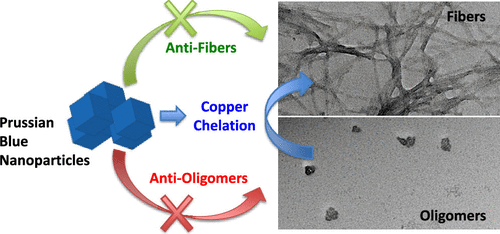当前位置:
X-MOL 学术
›
Biomacromolecules
›
论文详情
Our official English website, www.x-mol.net, welcomes your feedback! (Note: you will need to create a separate account there.)
Dual Effect of Prussian Blue Nanoparticles on Aβ40 Aggregation: β-Sheet Fibril Reduction and Copper Dyshomeostasis Regulation
Biomacromolecules ( IF 6.2 ) Pub Date : 2021-01-08 , DOI: 10.1021/acs.biomac.0c01290 Joanna Kowalczyk 1 , Ettore Grapsi 1 , Alba Espargaró 1, 2 , Ana B Caballero 2, 3 , Jordi Juárez-Jiménez 1 , Maria A Busquets 1, 2 , Patrick Gamez 2, 3, 4 , Raimon Sabate 1, 2 , Joan Estelrich 1, 2
Biomacromolecules ( IF 6.2 ) Pub Date : 2021-01-08 , DOI: 10.1021/acs.biomac.0c01290 Joanna Kowalczyk 1 , Ettore Grapsi 1 , Alba Espargaró 1, 2 , Ana B Caballero 2, 3 , Jordi Juárez-Jiménez 1 , Maria A Busquets 1, 2 , Patrick Gamez 2, 3, 4 , Raimon Sabate 1, 2 , Joan Estelrich 1, 2
Affiliation

|
Alzheimer’s disease (AD), affecting almost 50 million individuals worldwide, is currently the first cause of dementia. Despite the tremendous research efforts in the last decade, only four supportive or palliative drugs, namely, acetylcholinesterase (AChE) inhibitors donepezil, galantamine, and rivastigmine and the glutamate NMDA receptor antagonist memantine, are currently available. New therapeutic strategies are becoming prominent, such as the direct inhibition of amyloid formation or the regulation of metal homeostasis. In the present report, the potential use of Prussian blue (PB), a drug that is in the World Health Organization Model List of Essential Medicines, in AD treatment is demonstrated. Both in vitro and in cellulo studies indeed suggest that PB nanoparticles (PBNPs) are capable of reducing the formation of typical amyloid-β fibers (detected by thioflavin T fluorescence) and restoring the usual amyloid fibrillation pathway via chelation/sequestration of copper, which is found in high concentrations in senile plaques.
中文翻译:

普鲁士蓝纳米颗粒对Aβ40聚集的双重影响:β片状原纤维的减少和铜动态平衡调节。
阿尔茨海默氏病(AD)目前影响全世界近五千万人,是痴呆症的首个病因。尽管在过去十年中进行了巨大的研究,但目前仅有四种支持或姑息药物,即乙酰胆碱酯酶(AChE)抑制剂多奈哌齐,加兰他敏和卡巴拉汀和谷氨酸NMDA受体拮抗剂美金刚。新的治疗策略正变得越来越突出,例如淀粉样蛋白形成的直接抑制或金属稳态的调节。在本报告中,展示了普鲁士蓝(PB)在世界卫生组织基本药物标准清单中的药物在AD治疗中的潜在用途。无论在体外和在纤维素的研究确实表明,PB纳米颗粒(PBNPs)能够减少典型的β-淀粉样蛋白纤维的形成(通过硫代黄素T荧光检测),并通过铜的螯合/螯合来恢复通常的淀粉样蛋白原纤维化途径,铜在老年人中的浓度很高。斑块。
更新日期:2021-02-08
中文翻译:

普鲁士蓝纳米颗粒对Aβ40聚集的双重影响:β片状原纤维的减少和铜动态平衡调节。
阿尔茨海默氏病(AD)目前影响全世界近五千万人,是痴呆症的首个病因。尽管在过去十年中进行了巨大的研究,但目前仅有四种支持或姑息药物,即乙酰胆碱酯酶(AChE)抑制剂多奈哌齐,加兰他敏和卡巴拉汀和谷氨酸NMDA受体拮抗剂美金刚。新的治疗策略正变得越来越突出,例如淀粉样蛋白形成的直接抑制或金属稳态的调节。在本报告中,展示了普鲁士蓝(PB)在世界卫生组织基本药物标准清单中的药物在AD治疗中的潜在用途。无论在体外和在纤维素的研究确实表明,PB纳米颗粒(PBNPs)能够减少典型的β-淀粉样蛋白纤维的形成(通过硫代黄素T荧光检测),并通过铜的螯合/螯合来恢复通常的淀粉样蛋白原纤维化途径,铜在老年人中的浓度很高。斑块。


























 京公网安备 11010802027423号
京公网安备 11010802027423号